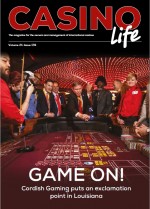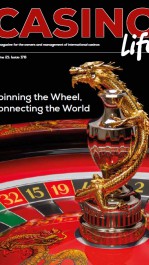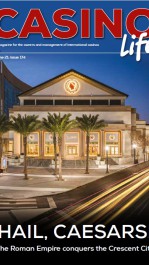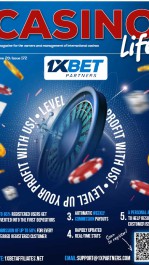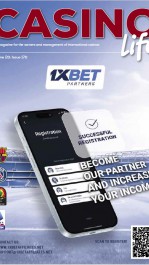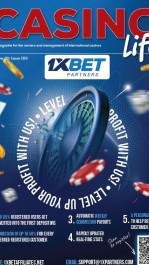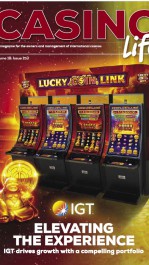A Roll of the Dice. By Edwin Ford
The game of craps, while a modern casino staple, has roots that stretch back thousands of years. The earliest known use of dice dates to ancient Mesopotamia, Egypt and China. These dice were crafted from animal bones, ivory and stone, and were
used for divination and games of chance. In these early societies, dice often served to predict the future and their use in gambling rituals became a popular practice.
The Romans and Greeks further refined dice games, where they were often used for gambling in public spaces. Archaeological discoveries from these civilizations indicate that the concept of betting on dice outcomes was widespread, with games of
chance becoming an integral part of social life.
The birth of Hazard in the 14th to 17th centuries
The direct ancestor of craps, the game Hazard, emerged in medieval France in the 14th century. It was popular among French noblemen and got its name from the French word for “danger,” reflecting the game’s risky nature. Hazard was typically played by
two players who bet on the outcome of the dice rolls.
Its popularity spread to England and eventually across Europe, where it became a mainstay in gambling circles. By the 17th century Hazard had become so popular that it reached the American colonies. Early versions of Hazard were more complex and had a wide range of possible outcomes, but as the game travelled it underwent simplification, especially once it arrived in America.
The American Revolution of craps in the 19th Century
In the early 19th century, Hazard evolved into the game we now know as craps. American soldiers stationed in New Orleans during the early 1800s modified the game to make it more accessible to a larger group of players. The game became known as “craps,” a corruption of the term “crapaud,” the French word for “toad,” which referred to the position some players took when rolling the dice.
The game quickly grew in popularity, particularly in New Orleans. By the time Nevada legalized gambling in 1931, craps was firmly established as one of the primary games in the newly emerging casino industry. It was craps that helped transform Las Vegas into a major gambling hub, with the game being available in almost every casino by the 1940s.
The classic craps table and the golden age of Las Vegas in the mid-20th century
By the mid-20th century, craps had become a defining feature of American casinos, particularly in Las Vegas. The game became known for its social aspect, with players gathering around the table and shouting out bets, cheering, and celebrating the outcome of each roll. The Pass Line and Don’t Pass Line were the core bets, with additional options for more advanced wagers like Come Bets, Hardways, and Place Bets.
During the 1970s, casinos like Binion’s Horseshoe in Las Vegas took craps to another level by offering some of the best odds in the city. Binion’s was famous for offering up to 100 times odds on the pass line, allowing players to bet much more than at traditional craps tables. This helped the casino attract professional gamblers and high rollers. The larger odds meant a lower house edge, which appealed to those seeking better risk-to-reward ratios.
However, these favorable odds came at a cost. Running craps tables with high odds required increased staffing and large payouts when players won, making the game less sustainable for many casinos. As a result, by the late 1980s Binion’s and other casinos scaled back the odds, focusing more on standard three times, four times, and five times odds on the pass line to better manage operational costs.
The decline of high-odds craps and standardization in the late 20th century
As casinos worked to control their costs and streamline operations, the once-popular high-odds craps game saw a decline. The increase in staffing costs, due to the need for multiple dealers and supervisors, combined with the increased payouts, made high odds craps unsustainable for many casinos. Many casinos around the U.S. returned to offering the standard odds of three to five times, which provided a more-manageable house edge of about 1.4 percent on the pass-line bet.
Despite this, craps continued to thrive as one of the most social and exciting games in casinos, often drawing large crowds to the tables. Casinos also began introducing other table games and slot machines, but craps remained a core attraction for serious gamblers and casino enthusiasts.
The decline of craps in the UK and Europe
 In the UK and many parts of Europe, craps faced a particularly difficult battle due to high staffing costs and operational inefficiencies. The need for a highly trained staff to manage craps tables, especially during peak hours, made it one of the most expensive games to operate. In many European casinos, where labor costs tend to be higher than in the U.S., this presented a significant problem. The cost of staffing several dealers per table, coupled with the complexity of the game, contributed to the decline of craps in these regions.
In the UK and many parts of Europe, craps faced a particularly difficult battle due to high staffing costs and operational inefficiencies. The need for a highly trained staff to manage craps tables, especially during peak hours, made it one of the most expensive games to operate. In many European casinos, where labor costs tend to be higher than in the U.S., this presented a significant problem. The cost of staffing several dealers per table, coupled with the complexity of the game, contributed to the decline of craps in these regions.
As a result, several UK and European casinos began reducing the number of craps tables or removing them altogether. The game became less profitable than table games like blackjack and roulette, which required fewer dealers and were easier to manage. By the early 2000s, craps was often a niche offering in European casinos, whereas games like roulette and baccarat continued to dominate the floor.
In the UK, the introduction of more cost-effective games like electronic roulette and automated blackjack further exacerbated the decline of craps. The shift to automated and electronic gaming options in European casinos also helped reduce the staffing burden, making traditional table games like craps less attractive.
The rise of electronic craps: The early 21st century
As technology continued to advance, so did the evolution of craps. The early 2000s saw the rise of electronic versions of craps, where players could make their bets via touch-screen displays and watch a computerized simulation of the dice rolls. These electronic craps machines offered a more efficient and accessible way to play craps, particularly in venues where staffing resources were limited.
One of the most significant developments in electronic craps to date came from Aruze Gaming. In 2017 the company released its electronic live craps, called Roll to Win Craps. Aruze’s innovation combined the traditional excitement of craps with the convenience and cost-efficiency of modern technology. The system only required a stick person (a single dealer to manage the dice), as the rest of the game was automated.
The electronic live-craps system allowed players to place bets via interactive touch-screen displays while a stick person supervised the dice roll. The outcome of each roll was displayed on high-definition screens, and cameras ensured that the dice rolls were transparent and random. This innovation drastically reduced staffing requirements and provided a more streamlined, fast-paced gaming experience.
Casinos quickly adopted electronic live craps due to the lower operational costs, faster game play and the reduced need for dealers. It was particularly popular in venues seeking to maximize efficiency without sacrificing the excitement of traditional craps. In 2019 Aruze was taken over by Interblock Gaming, which now distributes the product.
Online and mobile craps: 2010s – present
As the online gambling market expanded in the 2010s, online craps became a popular feature in virtual casinos. These games were often modeled after traditional craps tables, using random number generators (RNGs) to simulate dice rolls. Players could access the game from their computers or mobile devices, allowing them to enjoy craps from the comfort of their own homes or on the go.
Additionally, the rise of live-dealer craps provided an immersive experience by streaming real-life dealers rolling dice at physical tables in real time. Players could interact with the dealers and other players via live chat, combining the social aspect of traditional craps with the convenience of online play. This format allowed players to experience the excitement of a real craps table without being physically present in a casino.
Mobile craps apps, optimized for smartphones and tablets, also became widely popular. These apps offered a portable way to play craps anywhere, anytime and further expanded the reach of the game to a younger, more tech-savvy audience.
The present day: The future of craps and continued innovation

Today, craps continues to evolve in both land-based and online casinos. Innovations like virtual reality (VR) and augmented reality (AR) are likely to shape the future of the game, offering even more immersive experiences for players who seek a more interactive and futuristic gambling environment.
Casinos are also experimenting with hybrid gaming, combining traditional and electronic versions of craps on the same floor, allowing players to choose between a live, dealer-run game or a faster, electronic version with automated betting systems.
While craps still faces challenges—particularly in the face of the rising popularity of electronic and online gaming—it remains a cornerstone of the casino industry. Its ability to adapt and evolve through technological innovations like electronic live craps and online play ensures its continued relevance in the gambling world.
Conclusion
From its humble beginnings in ancient dice games to its modern-day forms, including electronic live craps and online versions, craps has undergone a remarkable transformation. Whether it’s played at a crowded casino table, through an electronic machine, or online with a live dealer, craps remains a thrilling and dynamic game that blends the excitement of chance with the communal atmosphere of social gambling. As technology continues to shape the future of gaming, craps will undoubtedly remain one of the most enduring and beloved games in the world of casinos.
About Author
Edwin is a highly motivated, flexible and results-driven senior executive with extensive experience in strategy, sales, business development and commercial operations, developed through over a four-decade career in the gaming industry. Training, working and supervising in casino operations to an executive level , spanning over 15 years, he also operated and was a shareholder of several software-development and supply houses, leading development and deployment of new technologies across international markets.
He displays a skill set transferable to almost any business sector, experienced in consulting with the ability to drive any organisation to realize its goals.
In recent years he has handled licensing applications for several companies with a 100 percent success rate. After 46 years in the industry his passion for the sector is still strong.
*** This article was originally published in the May 2025 edition of Casino Life Magazine Issue 176***


